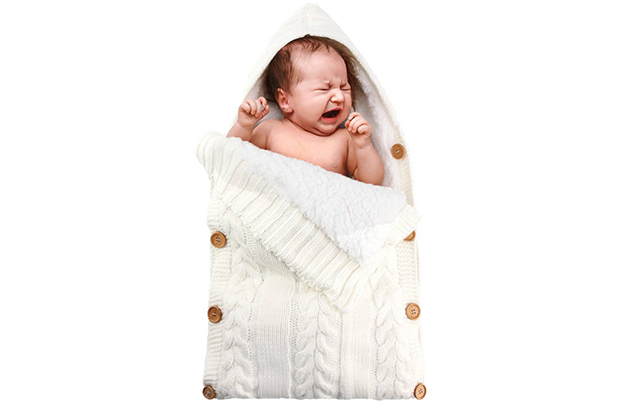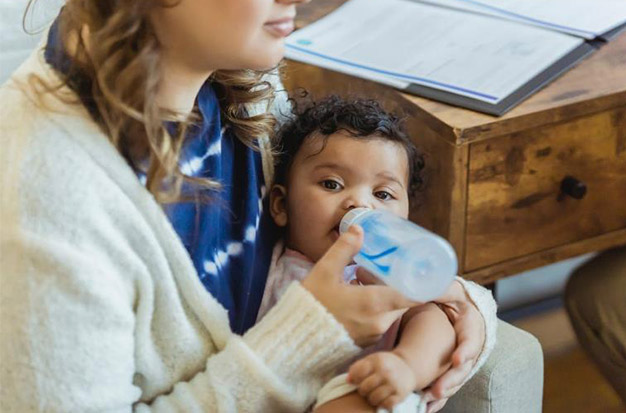If you think that your baby wants their hands out of the swaddle and you’re trying to figure out how to (safely) get some sleep, you’re in the right place!
Swaddling simulates the cramped conditions of the womb, and, let’s face it, they loved it in there!
However, while being swaddled, your baby is sort of forced to accept how you position them, whereas in utero, they had the choice to keep their hands close to their head or chest.
What then should you do if you have a baby who doesn’t want their hands covered up?
Should you wrap the swaddle more loosely—or is that a SIDS risk?
Do you need to purchase a different kind of swaddle?
Do you even need to keep wrapping?
Why Do Babies Escape From The Swaddle?
Most of the time, when your baby struggles with the swaddle, it’s because your swaddling technique needs a little tweaking. (Please see my tutorial on the DUDU method for swaddling a baby. My preferred method for swaddling will be demonstrated in these step-by-step instructions so your child can sleep comfortably.) The startle (also known as moro) reflex was also present when your child was born. When your child is startled by something, like a loud noise or a sudden movement, they may flail and stretch out their arms as a result. This means that if the swaddle is not tight enough, your baby can easily escape.
Why Do Infants Sleep With Their Arms Encircled?
Swaddling is intended to provide comfort to the baby by giving him or her a snug, wrapped-up feeling. All wrapped up like a little baby burrito, she is at the ideal temperature and is at peace. Her arms being wrapped in the swaddle makes her feel like she is still in the womb. Having her arms wrapped around her should help your baby fall asleep as she adjusts to life in the outside world. Enjoy all of those newborn moments while they last, especially if they help baby fall asleep, because that will change as baby grows and develops.
When Swaddling Infants With Their Arms Out, Is It Safe?
For infants who struggle to keep their arms inside the swaddle, the Dreamland Baby weighted sleep swaddle is a fantastic option. The Dreamland swaddle can be worn three ways without risk of injury because of the simple-to-use, integrated swaddle band:
- both arms out
- one arm in
- both arms in
Your baby will feel calmer, fall asleep more quickly, and stay asleep for longer thanks to the gentle, evenly distributed weight.

6 Tips For Babies Who Want Their Hands Out Of The Swaddle
Consider Whether It’s Still Safe To Swaddle.
Many parents are unaware that when a baby shows signs of being able to roll over, swaddling poses a serious safety risk.
Here are a few illustrations of rolling symptoms:
- Arching his back and pushing his head back
- Raising legs in the air and swaying his hips
- Throwing both arms over to one side
- Pushing off a surface with his leg(s)
- Rocking back and forth to the side
When your infant rolls over onto his side while still awake, it’s most likely a sign that he’s about to roll over.
Any of the aforementioned symptoms would suggest that it’s time to stop swaddling. This is due to the high risk of death if an infant in swaddling rolls onto their stomach.
If your baby is over the age of 8 weeks or has already started rolling, stop reading this post and start reading this one:
For babies who have not yet reached the aforementioned milestones, all of the advice that follows is appropriate.
Try The “arms Up” Swaddle
For many babies, it’s less important to have their hands out than it is to have their arms up by their head.
(During ultrasounds, you might have noticed your infant in this position!)
This swaddle sack should be tried if you haven’t already.
It holds your baby’s arms so they won’t be startled and places them in their preferred position.
We adored this product so much that I ended up purchasing a backup to use when the first one got soiled.
Give Your Baby Exactly What They Want
There are two ways you can go about it:
- Keep their arms above the swaddle blanket and swaddle them tightly at armpit level.
- Utilize a swaddling sack with wings, such as this one. Your baby’s arms should remain free while you wrap the wings around their chest.
Many babies only require compression around the torso to feel secure.
Important Safety Notice
When using a swaddle blanket, the swaddle must be snug and secure around the infant’s upper body, no matter the position of their arms.
Never wrap your baby in a swaddle that’s loose at the top, as this poses a suffocation risk
Try Swaddling With Just One Arm Out
Sleeping with one arm free is a good intermediate step if you find that your baby’s startle reflex is still too strong to be swaddled with both arms out.
There are three ways you can go about it:
- Give them a tight swaddle at armpit height, leaving one arm exposed.
- Use the swaddling sack with wings mentioned earlier. The wings should be fastened around the baby’s chest so that one arm is restrained and the other is free.
- Use a swaddle transition bag like this one that has a zipper that you can use to remove one (or both) wings.
Try Swaddling With Baby’s Arms Inside The Swaddle
Many parents think that their baby doesn’t like being swaddled, but often the baby just doesn’t like how they’re being swaddled.
Even though it goes against logic, try these to see how your baby reacts:
- Swaddling with arms straight down
- Swaddling with arms across baby’s chest
Drop The Swaddle
And lastly, think about doing away with the swaddle altogether!
Babies do not have to be swaddled. Swaddling is a common practice because babies frequently prefer it, but there is no safety benefit to it.
Here are two alternatives if your baby doesn’t enjoy being swaddled:
- Use a sleep bag instead. (You can read in detail about this here).
- Make sure your baby is dressed appropriately for bedtime; avoid using a sleep sack or swaddle at all costs. (You can find all the information you need about this right here.
You can avoid the hassle of transitioning when your child is closer to 8 weeks by quitting swaddling now.
This might be a wise course of action since the time is running out to stop swaddling in either case!
Is It Acceptable If The Baby’s Arms Accidentally Slip Out Of The Swaddle?
You may be wondering when to start swaddling with arms out if your baby’s arms keep inadvertently slipping out of the swaddle. Some infants like to have their arms left out while being swaddled. While this is normally ok, it could become hazardous if the remainder of the swaddle slips and ends up covering the baby’s face. Similarly, if baby rolls over, she might not be able to roll herself onto her back, which can also present a risk. Although each baby is unique, the milestone of rolling over usually happens between 2-4 months. It might take longer or even happen sooner for some people. It might be time to switch to a sleep sack if you believe your baby is sleeping with his or her arms out due to discomfort.
When Should You Take The Arms Out Of The Swaddle?
Because every baby is unique, what is comfortable for one baby might not be for another. Given this, there is no specific period of time for when to swaddle with the arms out. One or even both arms can be left out of the swaddle, according to experts, unless the baby is extremely clumsy and the swaddle becomes so loose that it covers your baby’s nose and mouth. For newborns, this is typically not a problem, but by the time your child is 2-4 months old, they will probably be beginning to roll over. If this is the situation and her arms simply aren’t staying in the swaddle, it’s time to stop using the swaddle.
Conclusion
As long as your child is under 8 weeks old and hasn’t started to roll over, you have a few options when they want their hands out of the swaddle.
Finding what works best for your child may require some trial and error. A baby can be swaddled with their arms raised, with one or both arms free, in various positions inside the swaddle, or without the swaddle at all. You can count on your child to share their favorite things with you.
Keep in mind that you should count yourself lucky if your child doesn’t require the swaddle to fall asleep. One less transition to manage later is a good thing.



